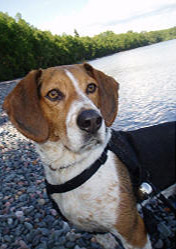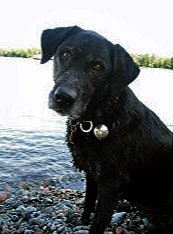Health Topics
Northern Summer Survival Guide for Pets
Tips on dealing with several summer hazards.
(By Julie Stone RVT)
Heat Stroke
Signs: Heavy panting, difficulty breathing, vomiting, rapid pulse, high body temperature (rectal temp. over 41C or 106F) or collapse.
First Aid: Cool the pet with cool water. You can also use wet towels. Do NOT use cold water. Keep them wet and cool. Monitor rectal temperature, when it reaches 39.5C (103F) dry the pet off and and discontinue cooling. Encourage the pet to drink water, but do not force it. Contact your veterinarian.
Prevention: Prevent heat stroke from occurring by not leaving pets unattended in your vehicle during the summer months, as this is the most common cause of heat stroke in companion animals. If you MUST leave them, make sure the windows are open enough for air circulation, park in a shady area, and never leave them alone for more than 10 minutes. Also leave water available for them to drink.

Insects
Signs: Pain, swelling, presence of stingers.
First Aid: Remove the stinger if present. Use tweezers if available. Apply cold packs to the area to help reduce swelling and pain. If available you can apply 1/2% cortisone cream. Contact your veterinarian if severe swelling occurs or if the pet is having difficulty breathing.
Prevention: Help your pet combat the summer bugs by applying Bush Splash Spray ® regularly when camping and hiking. It's an all-natural bug repellant safe for both kids and pets.
Tick Removal: For attached ticks we recommend using Tick Twisters ® an awesome product that comes in two sizes depending on how engorged the tick is. Simple to use, just slide the forked end of the twister underneath the tick's attachment site and twist slightly while pulling upwards (much like removing a nail from a piece of wood) and POP they slide right out, mouth parts and all. Clean the area with antiseptic soap and keep an eye on it for any kind of allergic reaction. Do not try burning the tick out, suffocating the tick or yanking it hard with a pair of tweezers. Most of these methods do not work properly and can leave parts of the tick still inside your pet. We also recommend a Lyme disease vaccine for those pets that travel in heavily populated tick areas.
Allergic Reactions
Signs: Swollen muzzle and/or eyelids, hives on their body, rubbing face.
First Aid: Apply cold packs to affected areas of the body. Give an oral antihistamine such as Benadryl®.
- Dogs: 25-50mg per dog every 8 hours (ie: a 60lb dog would require 50mg of Benadryl®)
- Cats: 10mg for a 10lb cat or larger.
Contact your veterinarian for further assistance or if the condition worsens.
Hot Spots
Signs: Moist inflamed itchy skin, found most commonly on dogs that swim a lot and have a dense coat. Often times they will lick and chew at the area and make it worse.
First Aid: Trim the fur around the affected area, as short as possible. Wash the area gently with an antiseptic soap and apply something such as Polysporin™ to the area.
Hot spots will usually require antibiotics, so a trip to your veterinarian is warranted.
Wounds
All wounds should be kept clean and covered. If the wound is deep and bleeding profusely apply a pressure bandage using gauze and if available use Vetrap™ (a 3M™ product) to keep the gauze in place until veterinary care is available. Vetrap™ can be purchased at most pet stores and veterinary hospitals. If the wound is superficial, clean the area and apply an antibiotic ointment such as Polysporin™ to the area. Some superficial wounds may not require veterinary care, but if angry looking, red or not cleaned well, they are prone to developing infection. Keep an eye on all cuts, scrapes and punctures and if they at all seem abnormal seek veterinary care.
Odds and Ends
A few last things to remember to help make your summer enjoyable and safe for both you and your pet...
- Wear a Bear Bell when hiking in areas known for bear sightings. These can be purchased in the camping department of most stores. They can also be put on your dog's collar.
- If your dog enjoys summer swimming and is prone to ear infections, using a product such as Oti-Calm® to clean the ears after swimming can help them avoid the uncomfortable pain of an ear infection. It helps to neutralize the bacteria and yeast in the ear canal that multiply when warm moisture is introduced to the ear canal during summer swimming.
- Always do a tick check after hiking or camping to ensure that your pet has not picked up any of these nasty fellows. It will also give you a chance to bond with your pet and make sure there are no new lumps or bumps present that you may not have noticed otherwise.
- Lastly HAVE FUN! Northern Ontario is full of beautiful places to hike and camp. Enjoy it, but remember "what you take into nature, bring out"! Clean up after your pets.


